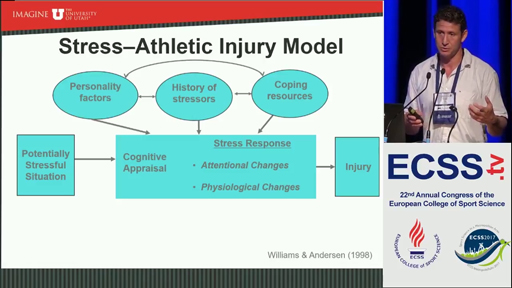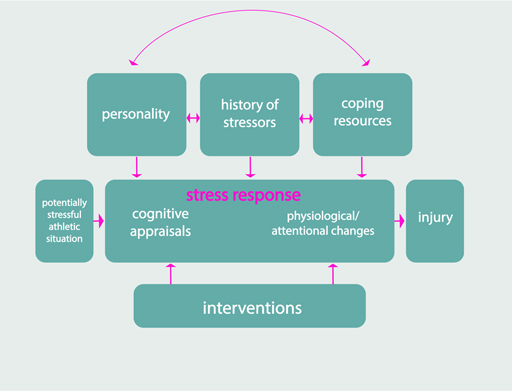2 Which psychological factors increase injury risk?
In the previous section you identified that there are various factors that can increase the risk of developing a sport injury, including psychological factors. In this section you will begin to explore what these psychological factors are and how they can potentially increase the risk of injury. There are two main psychological factors that have been identified as potential antecedents of sport injury – stress and personality. These both feature in a key model in this field – the Stress and Injury model (Williams and Andersen, 1998).
The Stress and Injury model (Figure 2) can be used to explain how psychological factors increase the risk of sport injury. When exposed to a potentially stressful situation the individual’s stress response will dictate whether or not an injury occurs. This stress response is influenced by three key things – personality, history of stressors and coping resources – and can be mediated through the use of interventions.
The next activity will help you to understand the model and its application.
Activity 1 Applying the Stress and Injury model
Watch Video 2 in which Lesley Podlog, a key researcher in the psychological aspects of sport injury, describes the components of the Stress and Injury model.

Transcript: Video 2
Now read the next instalment of Travis’s case study in the box below and try to apply the model to Travis. Alternatively, you may prefer to apply the model to yourself or someone you know who has experienced sport injury.
In the weeks leading up to his injury Travis had been under a lot of pressure at work as he had been promoted into a new role and was in charge of bidding for a new contract for his company. This led him to feel very stressed and he didn’t feel that he was coping very well with the stress of his new job role. Travis has always found it difficult to cope with high pressure situations. He has been finding it hard to switch off from work and was consequently feeling very tense. He had been experiencing muscle tension in his shoulders and had been short tempered at home in the days leading up to his injury. He came to the gym following an argument with his husband Trevor on the day that he sustained his rotator cuff injury during a heavy weight lifting session. When talking to his physiotherapist Lydia, he said that he had been quite distracted thinking about both the argument and the contract he was bidding on at work (the main source of his work-related stress). He felt that this caused him to use poor technique when lifting the bar which may have led to the injury. |
Discussion
If you apply the Stress and Injury model to Travis’s case study, you can see that Travis’s new job and being in charge of bidding for a new contract at work is a potentially stressful situation that Travis has cognitively appraised as being stressful. This appraisal has caused attentional changes (Travis was distracted when lifting weights as a result of thinking about the argument and the contract) and physiological changes (muscle tension in his shoulders) that could have led to his injury.
As the model shows, Travis’s cognitive appraisal and stress response has been influenced by personality factors (it seems that Travis is prone to finding it difficult to cope with high pressure situations), history of stressors (e.g. the change in job, argument with his husband) and a perceived lack of coping resources (he doesn’t feel he was coping well with the stress of his new job). The model suggests that interventions (strategies or techniques to help him manage stress) may have reduced his risk of developing an injury. As Travis didn’t use any such interventions the injury was more likely to occur. You will explore interventions to help reduce injury in Session 4.
Having explored the Stress and Injury model, you’ll now examine some of the mechanisms to explain how stress can lead to injury.

